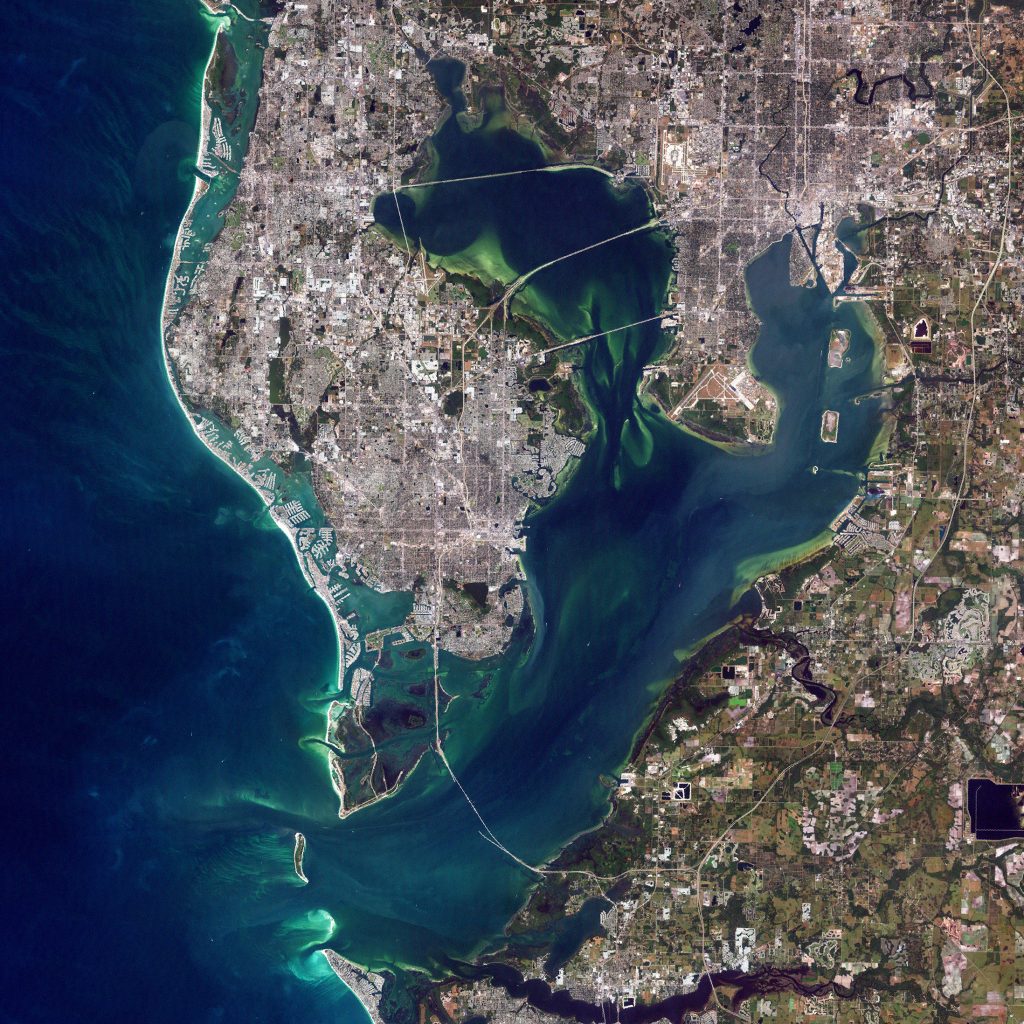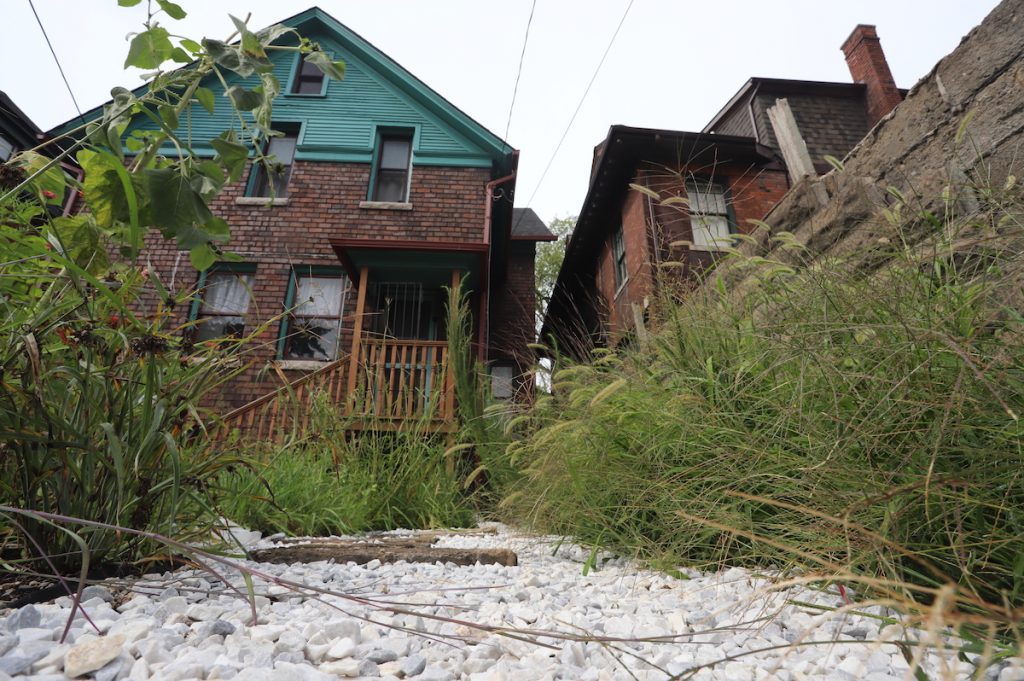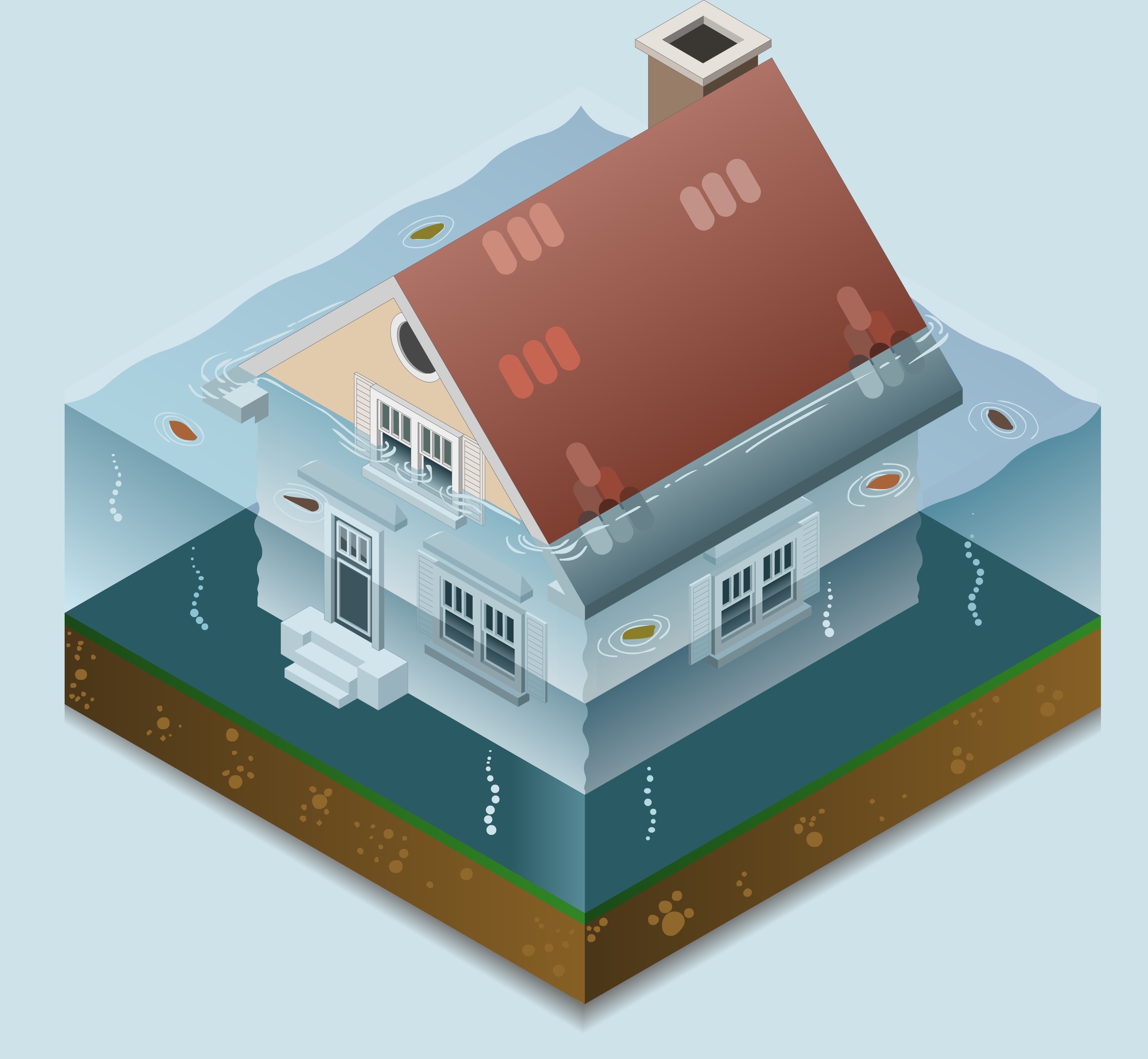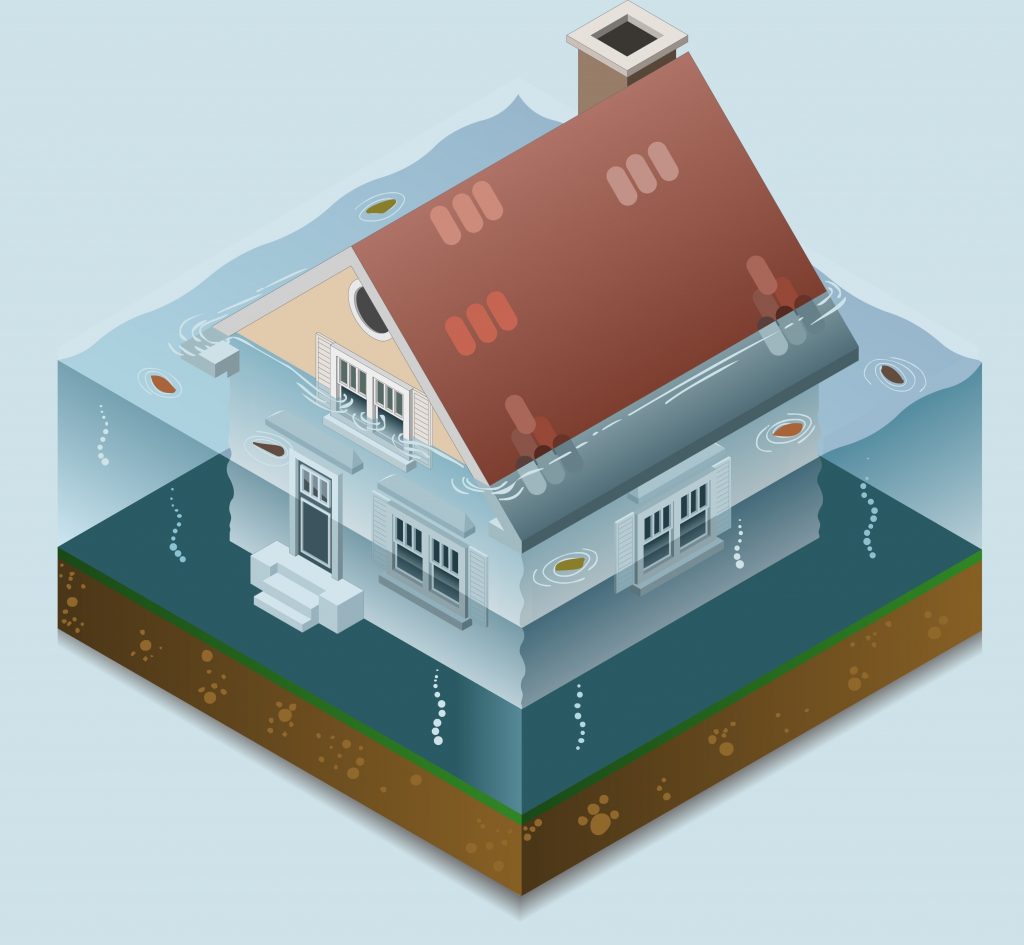What’s More Expensive Than Spending On Climate Change? Not Spending On It.
One morning last fall, I found myself standing in the basement of my 1895 home, watching a waterfall cascade off a brick wall in the basement. Bathrobed, beslippered, and not yet sufficiently caffeinated, I slowly realized the futility of attempting to actually do anything about it. This round was Mother Nature, 1, Disinvested Built Environment, 0. The previous owner of the home, an international power couple of absentee landlords, hadn’t bothered to replace the gutters that had been scrapped in years past. There were grading issues. And, as with any old house, there were “Even with a degree in this stuff and years of experience, I honestly have no idea what is going on here” issues. Renovating an old house in a Rust Belt city can be sort of like peeling an onion, with each layer revealing some ever more bizarre architectural forensics, until the bottom layer just turns out to be some schism in space-time that simply doesn’t add up.
Fortunately– at least as far as being able to fix the problem- it wasn’t an issue of broken public infrastructure, but rather of a broken, old house. When the adjacent homeowner rebuilt their sidewalk, they made sure that the dirt was nearly level with their new sidewalk, which meant that it was a few inches above our windowsills, hence the waterfall of rain. Thanks, suburban absentee landlords! But this was a matter of excavation and meandering of nylon liners and pebbles and drain pipes. In other words: things could have been so much worse. As a city inspector, I have seen unspeakable things– like sewage backed up to the top steps of the basement stairs- so this was benign.
Detroit, as many other cities, has begun a slow but steady push to disconnect rainwater sources from its sewer systems, meaning that in the case of increasingly severe weather, the likelihood of sewer overflow decrease substantially. Progress on this and implementation of widespread GSI has been anemic at best, and the water department remains a black box of mysterious dysfunction and poor customer service.
Indeed, when I was at the City, I was actually explicitly forbidden from making mention of stormwater disconnect ordinance violations to property owners. When I moved to Detroit, this was a huge issue, and I lost several hundred dollars of stuff in a basement flood in 2016 and also some stuff in a minor apartment flood in 2015 (insurance, both times, pulled a “gotcha” fine print moment, and I bade farewell to some coveted material possessions– though this is quite cathartic and good for movement down the spiritual path toward pervasive chill in the face of utterly ridiculous stuff happening to you).
Though they have their extremes, Great Lakes are reasonable in terms of weather. So, while a crazy thunderstorm isn’t unusual, there aren’t hurricanes, and things like major drought or wildfires are rare. Thus I am more attuned to the frequency of infrastructure failures than to the increased frequency of storms. But it got me wondering about quantifying the damages of extreme weather.
Failures of the built environment can be on a case-by case basis, or they can be on a district-wide or monumental, citywide scale. Detroit’s twin city of Windsor, in the Land of the Rising Timbit, has experienced catastrophic flooding in residential areas a couple of times since I’ve been in Detroit alone. Historically high water levels on the Great Lakes are prompting unending rounds of handwringing from politicians pestered by constituents to act, but unable to muster the courage to talk about climate adaptation. CBC Windsor reported just yesterday that unprecedented water levels and flooding have not slowed sales of beachfront property.
EXTREME CLIMATE AND THE ECONOMY
Because we’re isolated from the extreme storm systems that terrorize the southeastern United States every year and typically don’t see catastrophic tornados, the biggest threats in the Great Lakes are heavy rainfall and extreme cold. Northern parts of the Great Lakes region don’t even really get extreme heat at this point, but most of the Great Lakes region, flat and having been gradually stripped of wetlands, the ultimate drainage system, is prone to flooding in heavy rainfall.
But the systems are essentially the same. An illustration:
Let’s say a red state government knows that at some point within a period of a few months every year, a masked man will enter the state capitol building, parade into the governor’s office, and demand a check for anywhere from a few hundred million dollars to as much as a hundred billion. In addition to his uncanny ability to evade security guards and metal detectors, this mysterious figure also has the ability to convince the governor to cut a check every time. Every year, the masked man points out that the governor could avoid paying most of this quizzical ransom by investing a few billion dollars each year in infrastructure improvements, climate change mitigation efforts, and wetland restoration.
“I can’t spend money on that!” the dyed-in-the-wool Republican protests. “Anthropogenic climate change is a liberal lie!”
“Fine,” the stranger retorts, “I guess I’ll see you next year.”
This is a hyperbolic illustration that isn’t really that different from how it actually goes down. Politicians persist in treating extreme weather as an inevitability as opposed to a risk that can be mitigated. Dorian has already done billions in damages, and other recent storms have been far more costly.
NOAA isn’t entirely sure about the degree to which hurricanes are getting more frequent as a result of climate change, but they’re fairly sure that climate change is a major problem and is making storms more intense. Over the six years that we’ve recorded more than one Category 5 storm, three of these years have been since 2002.

But you need not rely solely on climate data: Urban growth along the Gulf Coast means that more damage will occur year-over-year by virtue of there simply being more stuff there. Florida’s population has increased twenty-fold in the past century and more than two hundred fold since the middle of the 19th century, while Texas, whose coast is also proximal to hurricane paths, has increased more than sixfold in the past century. Growth rates are more modest in the rest of the coastally exposed states, but the US Census Bureau nonetheless notes a near doubling of coastal population in a half century (1960-2008), with a 150% increase in population in the Gulf of Mexico region alone.
Also think that there are few dense urban centers in the Gulf Coast. A preponderance of sprawl means lots of vinyl siding and pole barn structures– things whose roofs are easily rended asunder by storms. Hundreds of billions, if not indeed trillions, of purportedly prime real estate, built without permanent protections against flooding, is exposed to potential catastrophic damage. Investment funds place protective hedges in the forms of derivatives that stand to profit or protect an underlying position from large price swings. Can you imagine not doing the same with real estate? Insurance clearly isn’t enough.

For kicks, though, let’s look at the GDP of the states typically worst hit by hurricanes. I’m defining this as Gulf and Atlantic states with the most exposed coastline, so, Texas, Louisiana, Alabama, Mississippi, Florida, South Carolina, and North Carolina. The cities– if we define cities as being municipalities with more than 100,000 people- most vulnerable to hurricanes are mostly in Florida, and, in terms of population, the larger cities of Tampa and Miami regularly make lists of places most vulnerable, as does the city of New Orleans. (Florida accounts for a large chunk of the Gulf Coast states’ 1,631 miles of coastline).
Pundits indulge in unending outrage over the cost of the supplemental nutrition assistance program (SNAP, or food stamps). This costs taxpayers about $71 billion per year and feeds millions of Americans, allowing them to, well, participate in basic metabolic processes involved with living, and, thereby, other economic processes, like contributing to the growth of the economy. Hurricane Harvey cost upwards of $125 billion in one single incident. No one really knows how much damage Hurricane Maria caused, but Puerto Rico alone shouldered over $100 billion in damages, and 3,000 people died. Dorian will be in the billions, and 59 deaths have already been recorded.
Pundits argue that food stamps are voluntary on the part of the government that provides it and on the part of the recipients that sign up. They also argue that poor people are lazy and dumb, and we can’t in any way plan for or meaningfully mitigate a crazy storm that threatens a populated area littered with stick-framed buildings and vinyl siding. What’s more, the idea that humans can meaningfully influence the planet is a liberal fantasy, right?
Think about the absurdity of this.
One recalls Mike Davis’ Ecology of Fear and wonder whether America at large epitomizes or indeed embraces this imagination of disaster as part of its perpetual, paranoid fear of destruction. As the President rails against Those Refugees or Those Rapists Crossing The Border, his base eats it up. But that base– largely concentrated in poor red states that already receive the lion’s share of welfare spending– overwhelmingly stands to be among the populations most vulnerable to extreme weather events. In other words, sustainability and climate change are most pressing to the most vulnerable people, who then vote for a party and a candidate that repeatedly deny the importance or even, indeed, existence of those issues.
While the same is true in the hood– that lower-income people of color by and large stand to be screwed the most readily by extreme weather events- this is true in any scenario considering populations that lack economic resources. It’s harder to move, it’s harder to maintain a house, it’s harder to afford things in general, so it’s much harder to shoulder the burden of a storm dumping water in your basement, extreme heat, cold, or, say, an economic downturn. But cities are generally moving much faster than rural areas owing to the economies of scale associated with green infrastructure improvements.
Lay down for a moment the Birkenstock-wearing, tree-hugging, crystals and chakras feel-good environmentalism. This can be about nothing more than dollars and cents, if that’s how we want to play it. We know that we can plan for these events. Short of addressing the very issues of climate change and parts per million of carbon, we may be able to mitigate these events by building better quality buildings, better quality neighborhoods, and better quality urban infrastructure. We also know that, at a very real level, these events will cost the economy hundreds of billions of dollars per year, and whether or not you think climate change is to blame, the number of billion-dollar events is on the rise, if as a result of unchecked, sprawling growth in the Gulf Coast and nothing else.

We will be forced to reckon with these effects sooner rather than later as the present overheated economy hurtles headlong the next market crash while absorbing hundreds of billions of dollars in storm damage from a single year alone. Insurers will drop coverage of homes, the national flood insurance program will require a bailout from the government that gave it license to, well, insolvently insure a bunch of homes that keep flooding.

As someone who is strongly motivated by the idea that markets can respond to climate challenges with regulatory intervention, I am not taking a doom-and-gloom approach as much as I am pointing out the fact that this stuff is getting really fucking expensive.
Solutions will necessarily be broken down into a few specific areas of focus in terms of climate change mitigation and adaptation:
- Macroeconomic / Regulatory (Federal): Major regulation has to focus on incentivizing a shift from fossil fuels. I am not sure how aggressive it has to be, but, while I am skeptical of doom-and-gloom portrayals from many of my fellow lefties, major moves have to begin now. I’m not sure if it is a carbon tax or cap-and-trade, but it certainly involves eliminating the fossil fuel subsidies we currently maintain. Oil companies have even lobbied for carbon tax, though, critics have pointed out, these efforts are dwarfed by their lobbying against environmental regulation.
- Regulatory (State & Local): State and local governments have many more tools at their disposal to effect better climate resilience initiatives at local levels. Banning companies from doing stupid stuff vis-a-vis aquifers. Programs at all levels of government should prioritize incentivizing habitat protection, restoration, and imposing stringent, credit-based systems for greenfield or wetland development.
- Architectural: Designing buildings that can withstand hurricane force winds and storm surges. Does this mean building all new buildings in flood-prone areas on giant reinforced concrete piers? How about entire neighborhoods that can withstand flooding? Probably that, too. Whatever gets built, it has to be done better than has been done in the past. (The problem here is that engineers are wont to pursue purely technical solutions– how to design a waterproof house, for example, rather than how to mitigate flooding through making better use of natural systems.)
- Infrastructural: People laughed at Henry Flagler (of Standard Oil and Miami, Florida fame) when he built a railroad to Key West– and it subsequently was completely destroyed in the 1935 Labor Day Hurricane, which killed 423 people, mostly World War 1 vets serving in the WPA. Less funny than destroying the pet project of a billionaire is when hundreds of citizens are killed, or when larger, more expensive things get destroyed and keep getting destroyed by storms.
Don’t get all hot under the collar about what it’s going to cost. It’s not some conspiracy to make money for irrelevant rich people or for George Soros And Her E-mails to take over your brain with Sharia Law. The costs are already being incurred, and they’re staggering– trillions over but a handful of years and hundreds of billions in any year, between flood insurance claims, infrastructure damage, lost productivity, congestion, waste, debris, destroyed landscapes.
We need to retool public budgets to indicate that protecting human beings from the environment and protecting the environment from wanton destruction is a major priority, and this can begin with an improved focus on how natural and manmade systems can work together to manage our relationship with the environment. Wall Street has already begun to attach marginal considerations in assessing creditworthiness and risk, suggesting that the systems must be considered in terms of not only ecologies and public infrastructure but also markets. Climate adaptation solutions are possible, expensive, and far cheaper than not spending on them.




